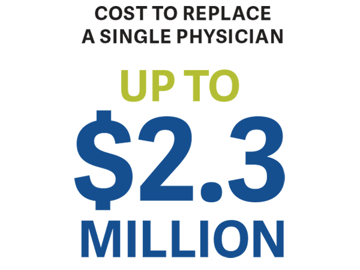With all of the bottom line worries that a healthcare leader has today, finding a budget to invest in well-being programs and other support for physicians can seem like a nice-to-have rather than an essential. But a cost-conscious leader wants to save money down the line, and the cost of not caring for physician well-being can be prohibitive.
 Care for physician well-being builds loyalty and saves money. When you create a culture of care in your organization, it tells your people you value them. Valued people are engaged and loyal; they stay with you. You want them to stay because on a 12- to 14-month model, the cost of replacing a single physician—taking into account recruiting, onboarding and getting the new hire up to speed—can be from a half-million to 2.3 million dollars. Turnover is expensive.
Care for physician well-being builds loyalty and saves money. When you create a culture of care in your organization, it tells your people you value them. Valued people are engaged and loyal; they stay with you. You want them to stay because on a 12- to 14-month model, the cost of replacing a single physician—taking into account recruiting, onboarding and getting the new hire up to speed—can be from a half-million to 2.3 million dollars. Turnover is expensive.
Reducing burnout makes business sense. A significant driver of turnover is burnout due to the immense pressures healthcare workers experience. The loss of focus and the reduced sense of efficacy that burnout breeds in physicians can result in:
- More medical errors
- Patient dissatisfaction
- Increased malpractice lawsuits
- The impact on other staff members whose workload increased due to physicians who reduce hours due to burnout.
And there’s more. In the wake of COVID-19, clinicians may be experiencing:
- Moral injury
- Second victim syndrome
- Compassion fatigue
- PTSD
According to the Harvard Gazette, the cost of stress and burnout to healthcare organizations is $4.6 billion annually, and that equates to $7,600 per physician—that’s the cost of doing nothing about practitioner well-being.1
For more on investing in well-being, download our article, Investing in Physician Well-Being: The Smart Business Choice below or contact VITAL WorkLife directly to learn more.
Sources:
1 Alvin Powell, “Study: Doctor Burnout Costs Health Care System $4.6 Billion a Year,” Harvard Gazette, July 12, 2019. https://news.harvard.edu/gazette/story/2019/07/doctor-burnout-costs-health-care-system-4-6-billion-a-year-harvard-study-says/



